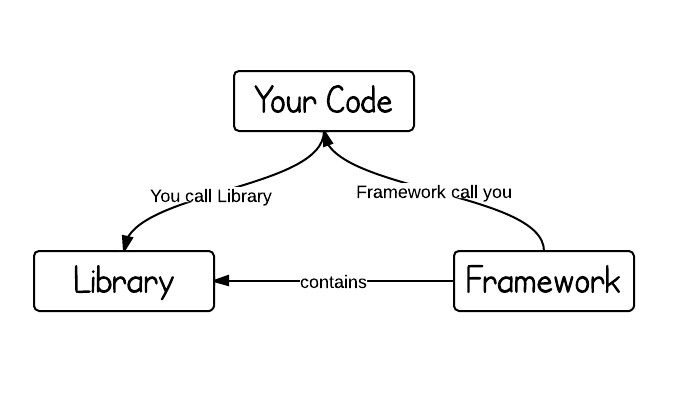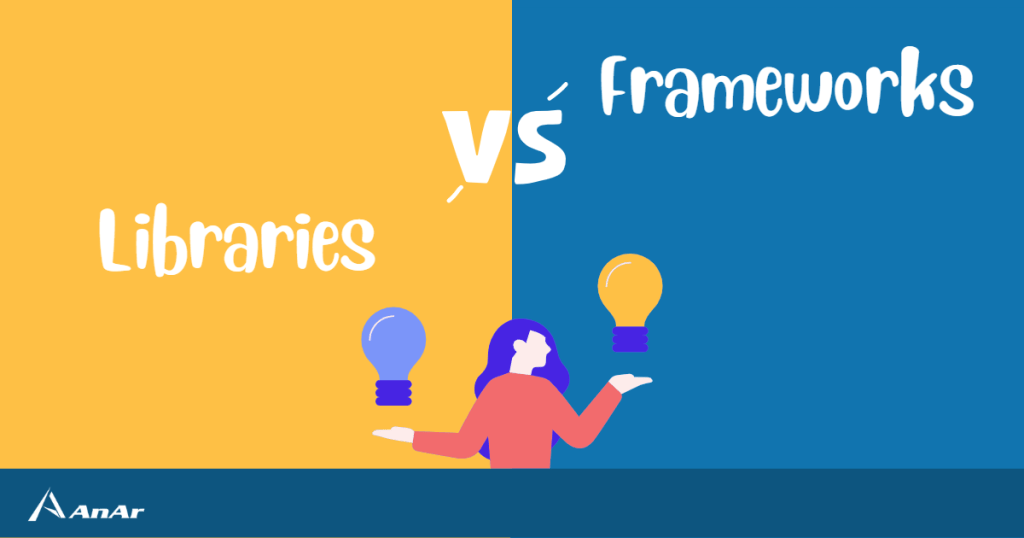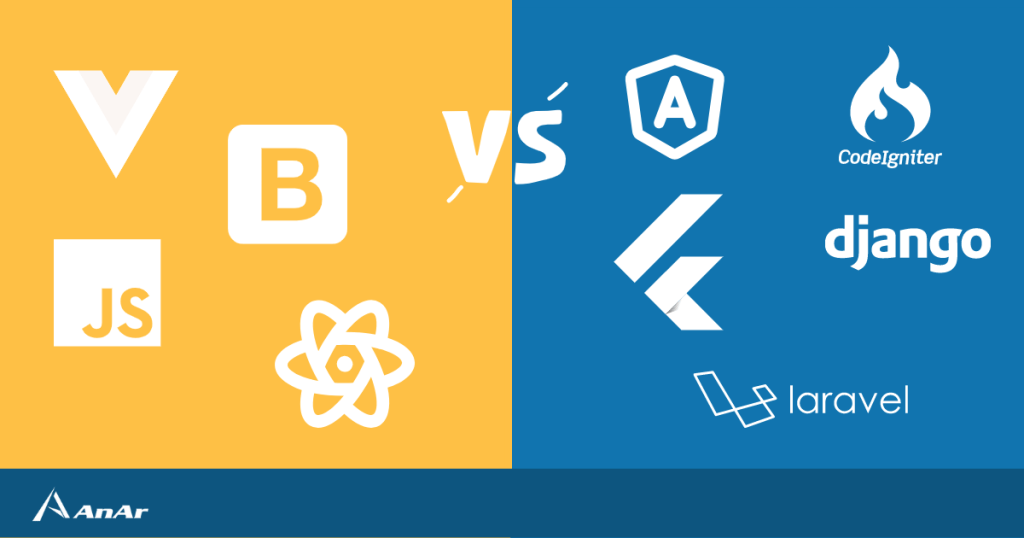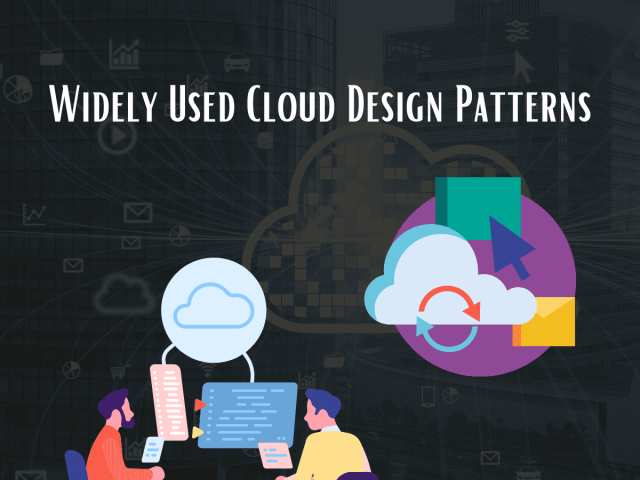When it comes to software development, the terms “library” and “framework” are often used interchangeably. However, there are crucial differences between the two, and understanding them is crucial for developers looking to create efficient and effective code. Let us review the comparison – Libraries vs Frameworks!
In this tutorial, we will delve deeper into the differences between libraries and frameworks, as well as explore their various aspects. We will define what a library is and provide examples of popular ones such as React and JQuery. Additionally, we will define a framework as a collection of libraries that implement a particular methodology. Some of the commonly known frameworks we’ll cover include Angular, Vue, Model View Controller, and Model View Presenter. Whether you’re an experienced developer or a learner, this tutorial will help you understand the nuances of libraries and frameworks and how to use them effectively in your projects.
Inversion of Control — The Key Difference
The main difference between a library and a framework is something called “Inversion of Control.” Libraries are a collection of functions that other programs can use, and you have complete control over when and how you use those functions. But with a framework, things are a bit different. The framework sets the rules for how your project is organized, and your code has to follow those rules. Instead of you calling functions from the framework, the framework calls functions from your code.
To make it even simpler, you can think of a library as a tool you use to do a specific job, like a hammer or a screwdriver. A framework, on the other hand, is more like a set of blueprints for building a house. The framework tells you how to build the house, and you have to follow the blueprint.
Before we delve into the intricacies of how these two differ, it is crucial to take a closer look at both of these terms.
What is a Framework?
The primary goal of a framework is to simplify and accelerate the process of application development for developers. It includes everything a developer needs to build big applications, like templates that follow best practices. Let’s take a look at how a framework works. If we’re using a framework with a graphical user interface (GUI), it calls the code using something called event handlers. If we’re using a web framework, it calls the code using a request-response model. If we’re creating a web application, we can use a JavaScript framework, which provides a structure with tools for fast development. Inside the framework, there are lots of pre-written pieces of code called libraries that provide developers with built-in features. This helps developers create applications without having to write everything from scratch, even if they don’t have extensive coding knowledge.
Advantages of a Framework
Using a framework can provide many advantages, such as making it easier to find and fix mistakes in your code, improving the way you write code, allowing you to reuse code more easily, and making it faster to develop applications. Now, let’s talk about the benefits of using a web development framework:
- Changes made to one part of the application won’t affect the entire application.
- Provides optimized processes for network traffic and caching
- Allows for faster web development with less code
- Supports creating applications for multiple platforms
- Creates a better user experience by making it easy to create dynamic and interactive content
Some JavaScript frameworks, like Angular, use data binding, which can make it easier to work with your data.
Limitations of a Framework
Using a framework can have some drawbacks. Here are some of the issues that can arise:
- The convenience of using a framework can prevent programmers from fully understanding the programming language.
- Customizing features can be difficult with limited options.
- Developing an application using a framework can sometimes be complicated.
- Choosing the right framework for the size of your application is important for performance and user experience.
- Separating business logic from the presentation layer in the Model-View-Controller (MVC) pattern can be challenging.
- Keeping up-to-date with new or deprecated features in different versions of the framework is important.
Use of a Framework
Frameworks are tools that make it easier for developers to create different types of software. Below are some of the main uses of frameworks:
- Web Development: This involves using different programming languages such as .Net (ASP.Net), PHP, Python, and JavaScript to create websites and web applications. Popular web development frameworks include ASP.Net MVC, CodeIgniter, Laravel, Django, and Angular.
- Artificial Intelligence: This involves using frameworks such as Apache Spark, PyTorch, and Tensorflow to build intelligent systems that can learn and make predictions.
- Mobile App Development: This involves using frameworks such as Xamarin, ionic, Native Script, React Native, and Flutter to create mobile applications that run on different platforms. Flutter is a UI toolkit created by Google that can be used to build beautiful, high-performance mobile apps.
What is a Library?
A library is like a collection of pre-written code that programmers can use to make their work easier and faster. It contains a set of functions and classes that can be used to complete tasks without having to write code from scratch. These pre-written functions can help simplify the process and save time. Most programming languages have a standard library, but programmers can also create their own custom libraries. Libraries usually have a smaller size and focus on specific tasks, such as working with strings, sockets, and input/output. Examples of libraries include jQuery and NumPy.
How does a Library Work?
Libraries are a collection of ready-made computer codes that can be reused in different software applications. They are designed to save time and effort for programmers by providing a set of pre-built functions, variables, and parameters that can be easily incorporated into their code.
For example, let’s say a programmer wants to create a program that can draw shapes on the screen. They could spend hours writing the code from scratch, or they could use a graphics library that has already been created and tested. The library would contain pre-built functions for drawing lines, circles, and other shapes, along with variables and parameters that can be customized to suit the programmer’s needs. By using the library, the programmer can save time and effort and focus on building the unique aspects of their program.
Using a library allows programmers to save time and effort by utilizing pre-built functions without worrying about the underlying code. This enables them to focus on building unique features for their application instead of spending time on tasks that have already been solved by others.
Advantages of a Library
A library is really helpful for computer programmers because it can make their work easier and faster. Below mentioned are some of the benefits of using a library:
- It can make a program run faster because the library is already compiled and tested.
- It has ready-made functions that can be used in the code without having to create them from scratch.
- It saves time and effort by providing code for complex functions that would otherwise have to be written manually.
- It stops programmers from writing the same code over and over again to solve the same problems.
- It gives programmers a choice of which libraries to use.
- It reduces the cost of building an application.
- It encourages programmers to create configurable and reusable libraries.
It provides code that has already been tested in different situations and environments.
Limitations of a Library
While libraries can be really helpful for computer programmers, they also have some limitations that need to be considered. Below are some points to bear in mind:
- If we use a library, our code becomes dependent on that library. This means that if we want to switch to a different library, we might have to change our code to work with the new one.
- If we use a library in an unsupported environment, we might need to add extra code to make it work, which can slow down our application.
- If a library isn’t supported by its developer, it might not work properly with new versions of our application.
- If we use several libraries that depend on each other, it can cause conflicts and slow down our application.
- Sometimes libraries have security vulnerabilities that can be exploited by attackers.
Before integrating a library into our code, it is crucial to thoughtfully weigh its advantages and disadvantages.
Framework vs. Library (Briefly)
Frameworks and libraries serve different purposes and have significant differences. Here are a few important distinctions to consider.
Few important distinctions to consider.
| Framework | Library |
| Enables speedy application development by offering readily available tools, guidelines, templates, and policies. | Offers pre-written code components that can be reused in our software program. |
| Controls the way libraries are called and utilized in our program’s code. | Our program’s code determines the time and place to implement a library. |
| To make use of the benefits provided by the framework, we can develop a new application following the guidelines and structure provided by the framework. | We can add a library to enhance the functionalities of an already existing application. |
| Ease to create and deploy an application. | Facilitates program binding. |
| Speeds up the process of developing an application. | Allows us to reuse a function in our software. |
| The goal of a framework is to simplify the software development process by reducing its complexity. | The goal of a library is to offer software functionality that can be reused. |
Conclusion
Both libraries and frameworks offer distinct advantages depending on your project needs. Libraries grant you more flexibility, allowing for tailored application design and development, though they may require more maintenance. Frameworks, on the other hand, provide comprehensive tools and guidelines that can expedite the development process, ideal for delivering client projects swiftly and efficiently. Choosing the right one is critical and depends heavily on your specific requirements and the challenges you face.
If you’re uncertain about which option is best suited for your project, or if you need guidance on integrating these tools effectively, don’t hesitate to reach out. Our team at AnAr Solutions is ready to help you navigate these choices to ensure your development process is both smooth and successful. Contact us today to see how we can assist you in making the most informed decision for your software development needs.









